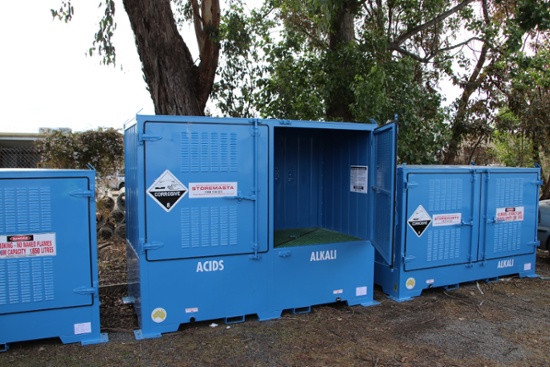The Australian Dangerous Goods Code classifies class 8 dangerous goods as “corrosive substances”.
Corrosive substances are materials that will cause severe damage to other materials such as metal, stone and human flesh by chemical action. The chemical process that corrosive substances take when they dissolve and damage other material is defined as “corrosion”. Corrosive substances have the ability to cause much damage to people and property and therefore it is very important that you store and handle corrosive substances in a safe and compliant manner.
Class 8 Dangerous Goods Requirements
The requirements for the safe storage and handling of corrosive substances is outlined in AS 3780 - The storage and handling of corrosive substances. Some of the requirements for the storage and handling of corrosive substances according to AS3780 will be highlighted in this post.
The Class 8 dangerous goods storage considerations include:
- Segregation from incompatible substances
- Separation from protected places
- Emergency decontamination facilities
- Compliant Class 8 storage
Let's look at each of these Class 8 DG requirements in more detail in the next section of our post.
Corrosive substances require specific storage requirements to remain safe and compliant.
Segregate Class 8 Dangerous Goods from Incompatible Chemicals
Just like most other classes of dangerous goods, class 8 corrosive substances are incompatible with a number of other dangerous substances. Incompatible classes of dangerous goods are those substances that are likely to increase the risk that they pose upon people and property when they are mixed. When incompatible classes of dangerous goods mix it can cause violent chemical reactions. Reactions between incompatible chemicals can cause severe fires that yield pungent toxic gases. To avoid the risk of dangerous chemical reactions and fires, class 8 dangerous goods must be safely segregated from other incompatible classes of dangerous goods. Some examples of dangerous substances that are incompatible with corrosive substances include Class 3 - Flammable Liquids and Class 5.1 - Oxidising Agents.
If the corrosive substances in your workplace have other sub-risks, it is important to segregate these substances from other corrosive substances that have incompatible sub-risks. Also some class 8 corrosive substances react dangerously with other substances within the same class. If a corrosive substance with a pH level below 7 (acid) is mixed with a corrosive substance with a pH above 7 (base), a neutralisation reaction will occur. Neutralisation reactions produce a lot of heat and gases which cause the corrosive substances to spit and splash.
All substances that are incompatible with class 8 corrosive substances must be segregated by a distance of at least 5 metres or stored in separate dangerous goods stores that have their own spill containment system. If you have a large store holding mixed classes of dangerous goods, the incompatible classes of dangerous goods can be safely segregated with separate chemical storage cabinets.
Separate Corrosive Substances from Protected Places
Corrosive substances are harsh chemicals that have the ability to dissolve materials such as human flesh. Acid burns can have severe effects upon your health and they often require professional medical treatment. To avoid harm to people and property, corrosive substances stores must be separated from protected places by certain distances.
According to AS 3780, protected places are defined as:
A factory, workshop, office, store, warehouse, shop or building where persons are employed.
The required separation distances of corrosive substances stores from protected places depend on the packing group of the corrosive substance that is being stored and whether the packages within the store are open or closed. The minimum separation distances according to AS 3780 are outlined below.
|
Minimum Separation Distances From Protected Places |
|||||
|
Stores With Opened Packages |
Stores With Closed Packages |
||||
|
PG I |
PG II |
PG III |
PG I |
PG II |
PG III |
|
10m |
5m |
3m |
5m |
3m |
3m |
Availability of Safety Showers and Eyewash Stations
If corrosive substances come into contact with your skin, eyes or face, it is very important that you wash the substance off immediately. If corrosive substances such as hydrochloric acid and sodium hydroxide come into contact with your skin, they would start to dissolve your flesh and cause severe burns. If hydrochloric acid came into contact with your eyes, there is a great chance that you would suffer permanent eye damage such as blindness. To reduce the risk of blindness and acid burns, eye wash stations, safety showers and water for the washing of hands must be available near all corrosive substance storage facilities that are not classed as minor storage. In fact, AS 3780 states that a safety shower, eyewash station and water for the washing of hands must be provided within 10 metres but no closer than 2 metres of all stores containing open packages of corrosive substances.
Store Class 8 Dangerous Goods in a Compliant Cabinet or Store
Another measure that must be taken to reduce the risk that corrosive substances have upon the people and property of your workplace is to ensure that all corrosive substances are stored in a compliant dangerous goods cabinet or store. The Australian Standard that outlines the design and construction requirements for corrosive substances stores is AS3780 - the storage and handling of corrosive substances. This standard outlines different construction requirements for indoor storage of corrosive substances and outdoor storage of corrosive substances.
Compliant store can assist with reducing the risks associated with Class 8 dangerous goods.
Indoor Storage of Class 8 Corrosive Substances
Corrosive substances can be safely stored indoors using a chemical storage cabinet. A compliant chemical storage cabinet must have:
- Self-closing close-fitting doors that hold shut by catches at two or more points. The doors must not open inward and they must be capable of being opened from within the cabinet.
- The cabinet must have a liquid tight sump in the base of the cabinet that is at least 150 mm deep and capable of holding at least 25% of the aggregate storage capacity of the cabinet.
- All shelves within the cabinet must be perforated to allow for free air movement within the cabinet.
Outdoor Storage of Class 8 Dangerous Goods
Corrosive substances can be safely stored outdoors using a chemical storage container that has been designed and manufactured in full conformance to AS 3780. A compliant corrosive substances storage container must:
- Be constructed from a corrosive resistant material or lined with a corrosive resistant coating.
- Have a spill containment sump that has the capacity to contain at least 25% of the aggregate storage capacity of the container or the capacity of the largest package, whichever is greater. The spill containment sump does not need to exceed 5000L.
- Have a least two means of access when the floor area of the store is greater than 25m2.
- Have the correct dangerous goods signage which includes a Class 8 Corrosive Substances Diamond.
IMPORTANT: Find out more about storing your corrosive substances outdoors by reading our helpful blog post, How Do You Store Corrosive Chemicals Outdoors?
Compliance for Class 8 Dangerous Goods
As corrosive substances are harsh chemicals that have the ability to dissolve human flesh and cause blindness, it is very important that you store your corrosive substances in a safe and compliant manner. Safe and compliant storage of corrosive substances can be achieved by following the guidelines outlined above and adhering to the requirements set out in the Australian Standard AS 3780. If you would like more information on the different risks associated with the 9 different classes of dangerous goods, download our FREE eBook by clicking on the image below.
Joining the team as a Dangerous Goods Storage Consultant, Melissa Hampton became Storemasta's Marketing Manager in late 2021. With extensive knowledge and experience in chemical compliance, Melissa is responsible for leading the Marketing team and helping shape their marketing strategy. In her spare time, you can find Melissa hiking, swimming and enjoying the great outdoors in beautiful north-west Tasmania.

